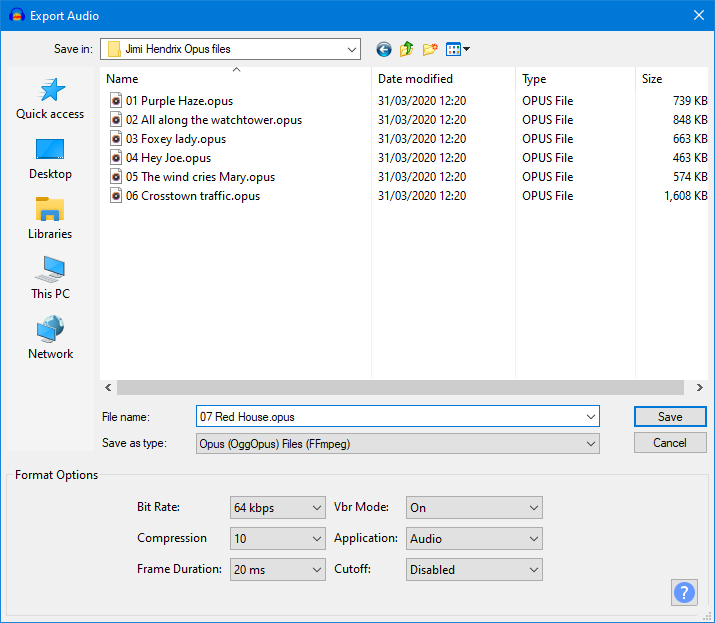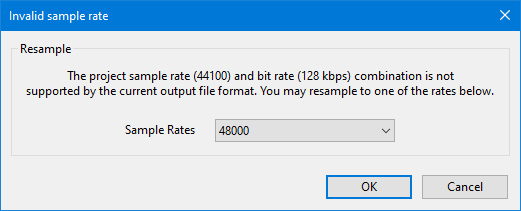Opus Export Options
For further details on OPUS see this Wikpedia page.
- Accessed by: then choosing Opus (OggOpus) Files (FFmpeg) from the Save as type dropdown menu.
- Also accessed by: then choosing Opus (OggOpus) Files (FFmpeg) from the Save as type dropdown menu. In this case the options dialog will appear in the center of the Export Multiple dialog.
Opus Export Setup
The Format options offer different ways to control the trade-off between the size and quality of the exported files.
Bit Rate
Opus Export in Audacity offers several different bit rate options for the export ranging from 6 kbps up to 256 kbps. The default is 128 kbps, Opus at 128 kbps (VBR) is pretty much transparent.
Opus at 64-96 kbps shows slightly superior quality compared to AAC and significantly better quality compared to Vorbis and MP3 at the same bitrate.
Compression
This controls the degree of compression used ranging from 1 to 10 (default).
Frame Duration
The Frame Duration ranges from 2.5 ms to 60 ms. The default is 20 ms.
Opus uses a 20 ms frame size by default, as it gives a decent mix of low latency and good quality, the default 20 ms frames are a good choice for most applications.
VBR Mode
This is the mode used for Variable Bit Rate. This can be:
- On: (default) will give you a variable bitrate to optimize the exported audio
- Off: will export a file with a constant bitrate, the rate that you set
- Constrained: sets an upper limit to the variable bit rate. Constrained prevents a very high bit rate peak from happening by setting an upper limit.
| Opus at 128 kbps VBR (default settings) is pretty much transparent. |
Application
This defines what use you will be making of the exported file
- VOIP: Voice over IP optimized for voice
- Audio: (default): optimized for audio
- Low Delay: useful for communication purposes (like voice calls, video conferencing or making music via the Internet), for which not only high compression ratios are necessary, but low latency is critical too.
Cutoff
This can range from Disabled (default) to Fullband.
The cutoff option sets the bandwidth of the encoder \xe2\x80\x93 bandwidth meaning the highest frequency that will be encoded.
While typically you would not restrict the bandwidth when encoding audio for home theater, music listening, etc., there are other use cases such as telephony or video conferencing, where it is not necessary to transmit the whole frequency spectrum.
| See this page from xiph.org on Opus Recommended Settings for these parameters. |
Opus Export rates
Opus export will only operate with a limited range of project rates ranging from 48,000 Hz down to 8,000 Hz. If you project sample rate is not set to one of: 8000, 12000. 16000, 24000 or 48000 you will see the following error message
This allows you to choose a temporary rate for project resampling for the Export to continue.

